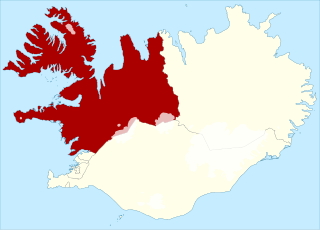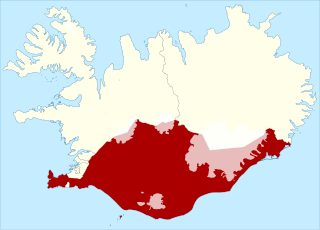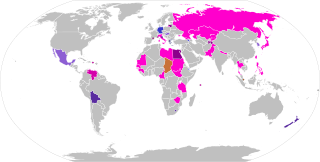
The Alþingi, anglicised as Althingi or Althing, is the supreme national parliament of Iceland. It is the oldest surviving parliament in the world. The Althing was founded in 930 at Þingvellir, about 45 kilometres (28 mi) east of what later became the country's capital, Reykjavík. After Iceland's union with Norway in 1262, the Althing lost its legislative power, which was not restored until 1904 when Iceland gained home rule from Denmark. For 641 years, the Althing did not serve as the parliament of Iceland; ultimate power rested with the Norwegian, and subsequently the Danish throne. Even after Iceland's union with Norway in 1262, the Althing still held its sessions at Þingvellir until 1800, when it was discontinued. It was restored in 1844 by royal decree and moved to Reykjavík. The restored unicameral legislature first came together in 1845 and after 1874 operated in two chambers with an additional third chamber taking on a greater role as the decades passed until 1991 when Althing became once again unicameral. The present parliament building, the Alþingishús, was built in 1881, made of hewn Icelandic stone. The unicameral parliament has 63 members, and is elected every four years based on party-list proportional representation. The current speaker of the Althing is Birgir Ármannsson.

Mixed-member proportional representation is a type of representation provided by some mixed electoral systems which combine local winner-take-all elections with a compensatory tier with party lists, in a way that produces proportional representation overall. Like proportional representation, MMP is not a single system, but a principle and goal of several similar systems. Some systems designed to achieve proportionality are still called mixed-member proportional, even if they generally fall short of full proportionality. In this case, they provide semi-proportional representation.
Parliamentary elections were held in Iceland on 10 May 2003. The Independence Party remained the largest party in the Althing, winning 22 of the 63 seats. The coalition government of the Independence Party and Progressive Party remained in office, with Davíð Oddsson continuing as prime minister.
Parliamentary elections were held in Iceland on 30 June 1946. The Independence Party remained the largest party in the Lower House of the Althing, winning 13 of the 35 seats.
Parliamentary elections were held in Iceland on 23 and 24 October 1949. The Independence Party remained the largest party in the Lower House of the Althing, winning 13 of the 35 seats.
Parliamentary elections were held in Iceland on 28 June 1953. The Independence Party remained the largest party in the Lower House of the Althing, winning 14 of the 35 seats.
Parliamentary elections were held in Iceland on 24 June 1956. The Independence Party remained the largest party in the Lower House of the Althing, winning 13 of the 35 seats.
Parliamentary elections were held in Iceland on 28 June 1959. The Independence Party and the Progressive Party both won 13 seats in the Lower House of the Althing. Following the tie, electoral reforms were introduced and early elections were held in October.
Early parliamentary elections were held in Iceland on 25 and 26 October 1959. Following the electoral reforms made after the June elections, the Independence Party won 16 of the 40 seats in the Lower House of the Althing.
Parliamentary elections were held in Iceland on 25 April 1987. The Independence Party remained the largest party in the Lower House of the Althing, winning 12 of the 42 seats.

Reykjavík North is one of the six multi-member constituencies of the Althing, the national legislature of Iceland. The constituency was established in 2003 when the existing Reykjavík constituency was split into two. The constituency currently elects nine of the 63 members of the Althing using the open party-list proportional representation electoral system. At the 2024 parliamentary election it had 47,600 registered electors.

Reykjavík South is one of the six multi-member constituencies of the Althing, the national legislature of Iceland. The constituency was established in 2003 when the existing Reykjavík constituency was split into two. The constituency currently elects nine of the 63 members of the Althing using the open party-list proportional representation electoral system. At the 2024 parliamentary election it had 47,619 registered electors.

Northeast is one of the six multi-member constituencies of the Althing, the national legislature of Iceland. The constituency was established in 2003 following the re-organisation of constituencies across Iceland when the Northeastern constituency was merged with the Eastern constituency and Siglufjörður municipality from the Northwestern constituency. Northeast consists of the regions of Eastern and Northeastern. The constituency currently elects nine of the 63 members of the Althing using the open party-list proportional representation electoral system. At the 2024 parliamentary election it had 31,071 registered electors.

Northwest is one of the six multi-member constituencies of the Althing, the national legislature of Iceland. The constituency was established in 2003 following the re-organisation of constituencies across Iceland when the Northwestern constituency was merged with the Western and Westfjords constituencies. Northwest consists of the regions of Northwestern, Western and Westfjords. The constituency currently elects six of the 63 members of the Althing using the open party-list proportional representation electoral system. At the 2024 parliamentary election it had 22,351 registered electors.

South is one of the six multi-member constituencies of the Althing, the national legislature of Iceland. The constituency was established in 2003 following the re-organisation of constituencies across Iceland when the Southern constituency was merged with municipalities of Gerðahreppur, Grindavík, Reykjanesbær, Sandgerði and Vatnsleysustrandarhreppur from the Reykjanes constituency and the municipality of Sveitarfélagið Hornafjörður from the Eastern constituency. South consists of the Southern and Southern Peninsula regions. The constituency currently elects nine of the 63 members of the Althing using the open party-list proportional representation electoral system. At the 2024 parliamentary election it had 41,002 registered electors.

Southwest is one of the six multi-member constituencies of the Althing, the national legislature of Iceland. The constituency was established in 2003 following the re-organisation of constituencies across Iceland when the Reykjanes constituency was split between the new South and Southwest constituencies. Southwest is conterminous with the Capital region but excludes Reykjavík Municipality which has its own constituencies, Reykjavík North and Reykjavík South. The constituency currently elects 12 of the 63 members of the Althing using the open party-list proportional representation electoral system. At the 2024 parliamentary election it had 79,087 registered electors.
Parliamentary elections were held in Iceland on 27 October 1923. Voters elected all 28 seats in the Lower House of the Althing and eight of the fourteen seats in Upper House. The Citizens' Party, a loose collection of conservatives, emerged as the largest party in the Lower House, winning 16 of the 28 seats.
Early parliamentary elections were held in Iceland on 18 and 19 October 1942. They were held after reforms were made to the electoral system following the July elections. The Independence Party emerged as the largest party in the Lower House of the Althing, winning 13 of the 35 seats.

Parliamentary elections were held in Latvia on 6 and 7 October 1928. The Latvian Social Democratic Workers' Party remained the largest party, winning 25 of the 100 seats.

A mixed electoral system is one that uses different electoral systems to elect different seats in a legislature. Most often, this involves a winner-take-all component combined with a proportional component. The results of the combination may be mixed-member proportional (MMP), where the overall results of the elections are proportional, or mixed-member majoritarian, in which case the overall results are semi-proportional, retaining disproportionalities from the majoritarian component. Systems that use multiple types of combinations are sometimes called supermixed.












